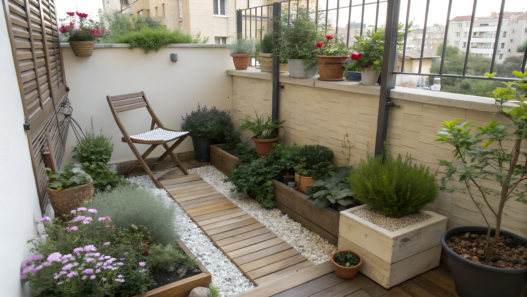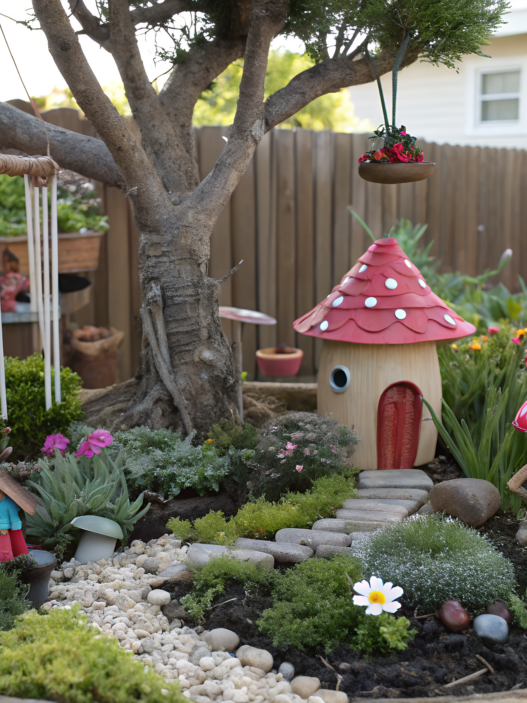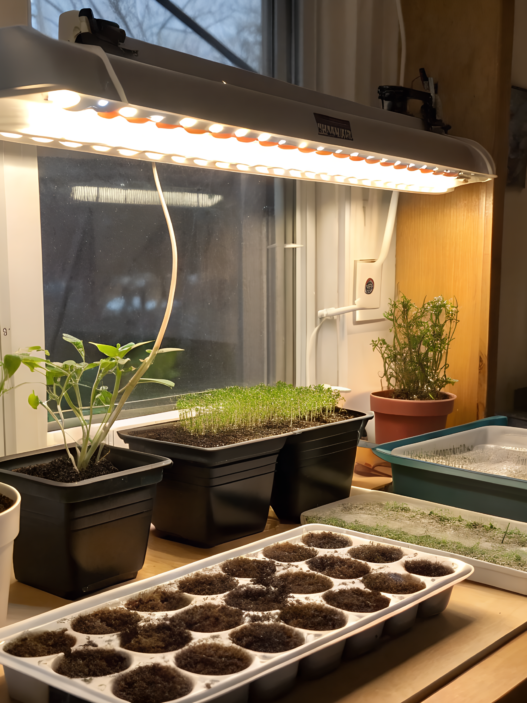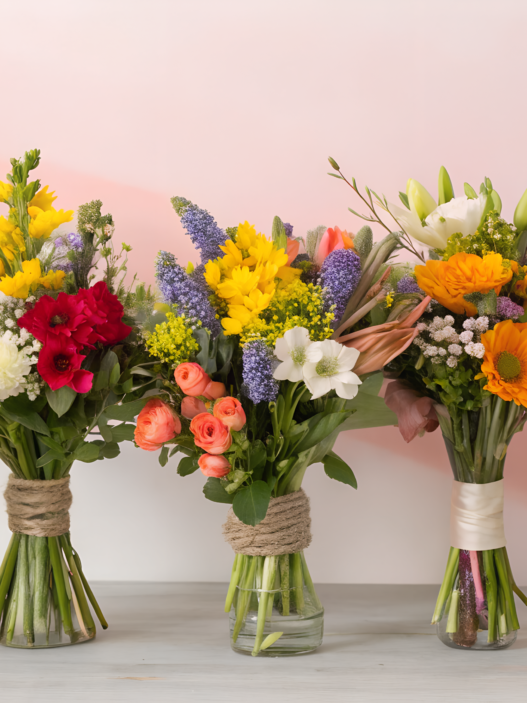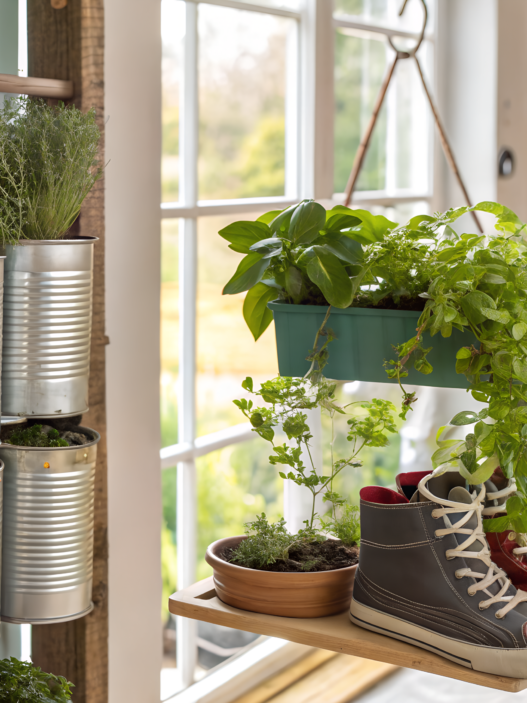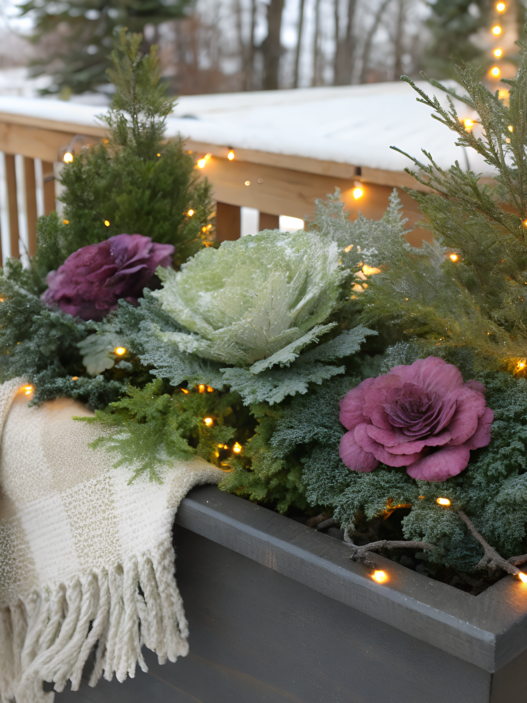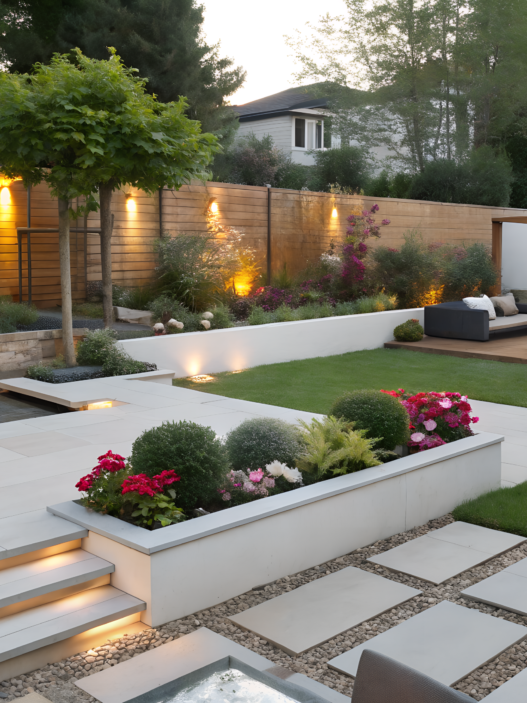Even if you only have a mini-balcony, a narrow patio or a tiny backyard, you can still create a green space even in that small area. And you don’t need an acre of land or a professional landscaper to do it, just a little creativity and a love of plants. Here are 10 mini garden ideas that will help turn even the smallest balcony into a real oasis. All these ideas are easy to implement, take up a minimum of space and are ideal even for urban apartments.
How to Build a Vertical Mini Garden on a Tiny Balcony
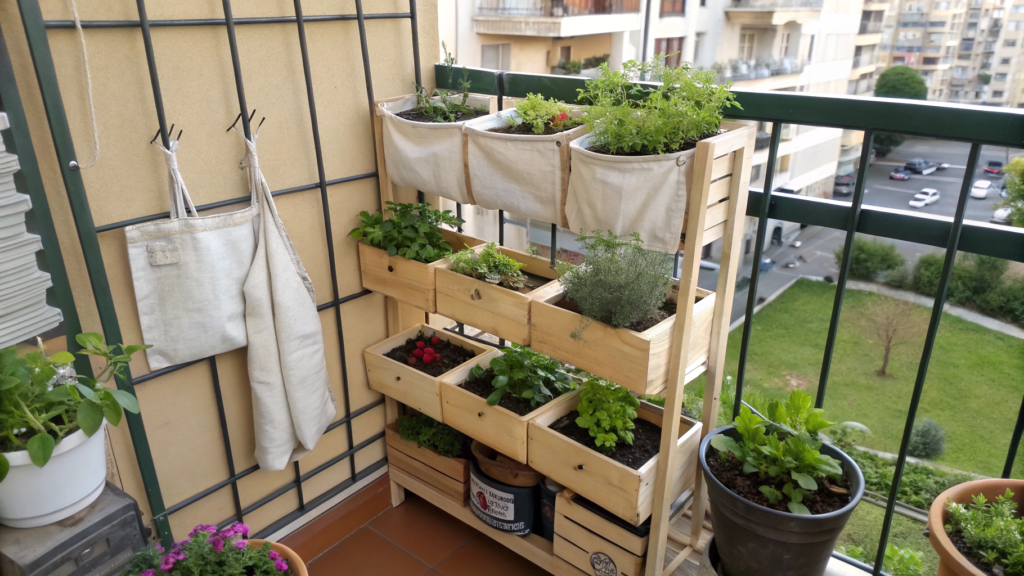
If you don’t have much space, of course, the best solution is to garden upwards, not wide. Vertical gardens are the only true solution for tiny balconies, because they allow you to place maximum plants without cluttering the floor. They are not only suitable for flowers, but also for herbs, mini vegetables and even berries!
How to make:
1. Pick a base
It can be a wall-mounted pocket garden, a metal grid with pots, or even an old wooden ladder. If you’re renting and can’t drill into the walls, use wall-mounted planters or mobile shelving units.
2. Pick the right containers
Pots should be lightweight but sturdy. Hanging fabric pockets (allow air to pass through, preventing water stagnation), wooden crates (don’t forget to make holes for drainage) or cachepots with hooks (you can hang them on the balcony railing) are good options.
3. Prepare the soil and drainage
For drainage, add expanded clay, gravel or vermiculite to prevent root rot.
Use a light, breathable soil mixture (ideally, a universal soil with coconut substrate).
4. Choose compact plants
Not all plants are suitable for vertical plantings. Best options: herbs and greens (basil, parsley, thyme, oregano). Curly plants: ivy, nasturtiums, clematis. Ampel vegetables: mini tomatoes, strawberries, peppers.
5. Take care of watering
Vertical gardens dry out quickly, so it is worth thinking about a drip irrigation system, which is easy to install even in an apartment or self-watering pots.
Tip. Suspended pocket cachepots are excellent for growing greenery and flowers. They allow you to grow several plants in one place. For example, this one is suitable for any balcony.
DIY Outdoor Mini Herb Garden That Fits on Any Patio

If you love to cook, a spicy herb garden is a must-have in your kitchen. Fresh basil, thyme, rosemary and mint are always on hand, even if you don’t have much space. You don’t have to run to the store – you just go out on your balcony or patio and pluck a fresh leaf right off the bush.
How to do it:
Choosing a container.
- For multiple herbs, a long, narrow box is most convenient. If space is limited, use tiered pots or hanging structures.
Choose the right herbs. Best to grow in a mini garden:
- Basil – fast growing, gives food a terrific flavor.
- Thyme – unpretentious, survives even with irregular watering.
- Rosemary – likes warmth, ideal for meat dishes.
- Mint – grows like a weed, the main thing is to limit overgrowth.
- Green onions – the easiest option, can be grown even in water.
Use the right soil.
- Herbs need a light, well-flowing soil. Universal soil with coconut substrate or sand will do.
- Don’t forget the drainage! Add a layer of expanded clay, pebbles or perlite to the pots to avoid water stagnation and root rot.
Do you have enough light?
- Herbs love lots of sun. If your patio or balcony doesn’t get 5-6 hours of direct light a day, consider LED phytolamps like this one, which helps herbs grow even in winter.
Homemade herbs are tastier, more flavorful and healthier – no chemicals, just pure, natural herbs.
Portable Outdoor Mini Garden for Renters: Move It Anytime!

If you rent your place, it doesn’t make sense to spend money on a stationary garden. But there is no such thing as a hopeless situation. A mobile mini garden is a genius solution where you can always take your favorite mini garden with you when you move.
How to make:
- Use containers on wheels or mobile raised beds.
- Choose lightweight pots. Plastic or fabric containers are much more convenient than clay containers.
- Grow mini vegetables. Great choices include salads, herbs, mini peppers and strawberries.
- Add an auto irrigation system. This will save time and keep plants from drying out if you often forget to water.
- Move the garden as needed – closer to the sun during the day, and you can bring it indoors in the winter.
Use soil for container plants, adding coconut substrate for lightness. Don’t forget to pre-pour a layer of expanded clay, gravel or vermiculite in the bottom.
Tip: Fabric bags are the best option for a mobile garden, they can be carried anywhere. They are lightweight, mobile and perfect for a temporary garden.
How to Grow Vegetables in a Tiny Mini Garden
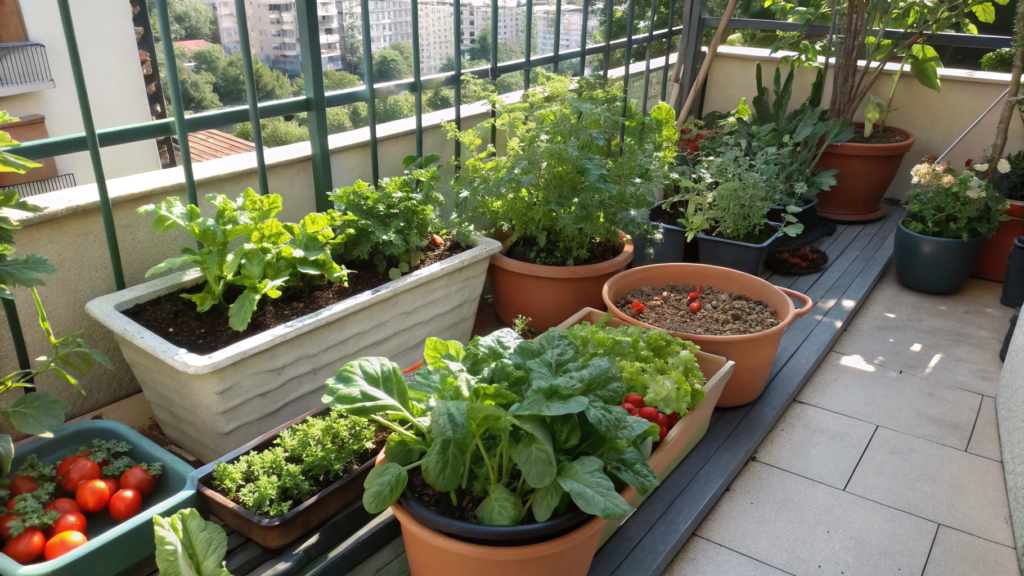
Yes, even in a small space, you can grow full-fledged vegetables. The key is to choose compact, productive crops, the right containers and place them in the right place for optimum growth.
What to grow?
- Leafy vegetables. Spinach, lettuce, and kale grow quickly in wide, shallow containers. Use light, nutritious soil for vigorous growth. These plants like semi-shade, so they can be grown even on shaded balconies and terraces.
- Compact vegetables. Mini peppers, cherry tomatoes and bush beans grow well in medium-sized containers (from 5 liters). Tomatoes require lots of sun (at least 6 hours a day), but beans and peppers can grow in light shade but do better in bright sun. Support tomatoes with a trellis or support to make them grow well upward.
- Root vegetables. Carrots and radishes do well in deep containers (30 cm or more) with loose, sandy soil so that the roots can grow freely. These vegetables are best placed in full sun, but shade them on hot days to avoid premature flowering. Choose low-growing carrot varieties such as ‘Paris Carrotelle’ or ‘Thumbelina’.
Tip. Use self-watering containers to keep your vegetables from drying out in the heat, especially if you can’t water them every day. It is best to place these pots where there is sun in the morning and light shade during the day to avoid overheating.
Hanging Basket Mini Garden for Outdoor Charms

Hanging baskets are always a lifesaver when space is tight. Not only do they add vertical greenery, but they also allow plants to cascade beautifully, creating a living waterfall effect of flowers and greenery.
Choose the right hanging baskets
- Coconut hanging baskets – they allow air to pass through and provide natural drainage, but they dry out quickly so require regular watering.
- Metal baskets with coconut or moss filling – provide drainage, but the moss or coconut fiber helps retain moisture longer.
- Fabric hanging baskets – lightweight, won’t overheat in the sun and retain moisture better than their wire counterparts.
Choose the right plants
- Strawberries – grow well in hanging baskets, forming a dangling cascade of berries.
- Ampel flowers (petunias, lobelias, nasturtiums) – fall in beautiful blooming waves.
- Ivy, tradescantia, scindapsus – unpretentious ornamental plants that fill the space with greenery.
- Cherry tomatoes and peas – great for hanging structures, if you tie them up.
Soil and drainage. Use light, moisture-absorbing soil, adding perlite or vermiculite for drainage. Before filling the basket, place a layer of coconut fiber or moss in the bottom to retain moisture and prevent soil leaching.
Water properly
Hanging baskets dry out faster than regular pots due to constant contact with air.
- Water daily on hot days and every 2-3 days during cooler seasons.
- Add hydrogel or lay a layer of mulch on top to prolong soil moisture.
- If you want to simplify care, install a mini drip irrigation system.
Tip. Wrap solar-powered garlands around your baskets and your garden will not only be green, but also glow beautifully in the evenings.
Japanese-Style Outdoor Mini Garden for a Zen Escape
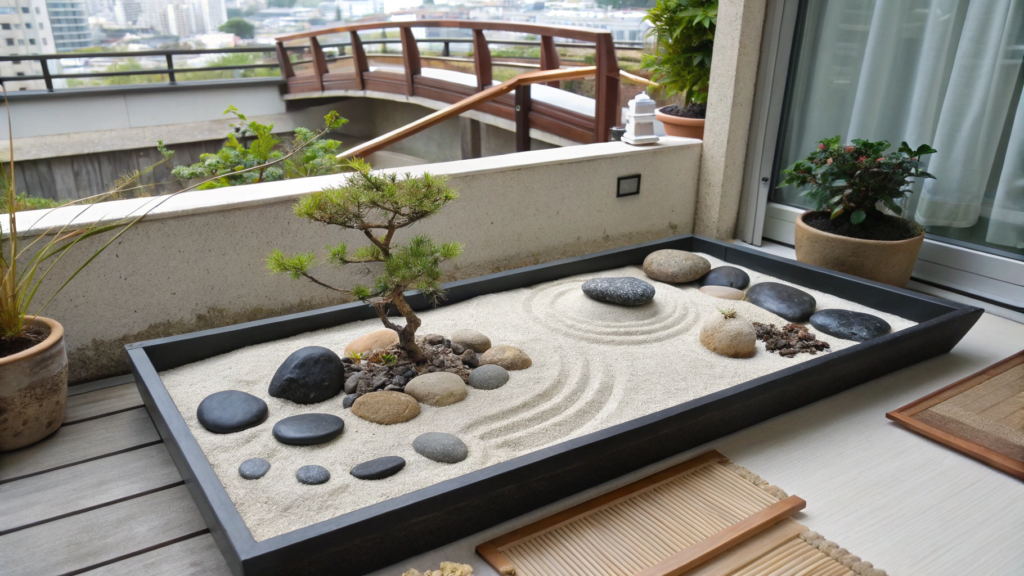
Minimalism, balance and harmony are the main principles of a Japanese mini garden. Such a garden helps to create an atmosphere of tranquility even on a tiny balcony or in a small yard. It not only decorates the space, but also creates a corner for meditation and relaxation.
Such a garden can be placed on the balcony, in the corner of the patio, at the entrance to the house or even on the table – the main thing is that the space looks clean, harmonious and uncluttered.
How to make:
To create a mini garden in Japanese style, we use a ceramic or stone tray, in which we will lay the necessary elements.
The base is stones, sand and pebbles
In traditional Japanese gardens, pebbles and stone paths symbolize the flow of water and the natural movement of nature. Best suited for:
- Fine pebbles or sand – to make rake patterns, creating the effect of waves
- Light-colored stones – for a feeling of airiness and lightness.
- Dark stones – to create depth and contrast.
Dwarf trees and conifers
Miniature pines, bonsai trees, dwarf cypress or ferns help to create a meditative atmosphere. If space is very limited, you can use compact plants in small ceramic pots.
- It is best to place trees at the edges of the garden so that they do not block the central composition.
Water element
If there is little space, a small ceramic bowl with smooth stones and water will do. In a larger garden, you can install a mini fountain – it will create a soothing sound of flowing water.
- It is better to put the water in the foreground of the composition, and place plants on the sides.
Moss and ground cover plants
Moss is a must in a Japanese garden. It covers the stones and creates a feeling of naturalness. Together with him you can add:
- Verbeyanik mint – quickly sprawls and resembles a green carpet.
- “Baby’s tears” (Soleros) – miniature plants that give the garden a lively look.
Moss likes humidity and semi-shade, so it should be sprayed regularly with water.
Tip. Distract yourself for 5-10 minutes to “comb” the sand and stacking stones, concentrate on how you feel. This is a good rest, which then allows you to work productively.
Pallet Mini Garden: The Ultimate Space-Saver
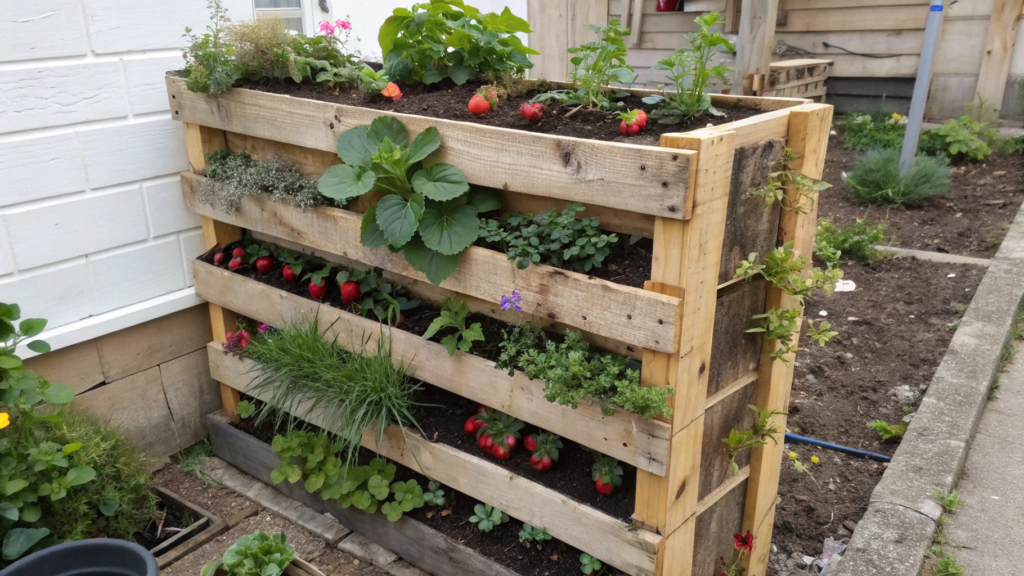
A wooden pallet garden is one of the easiest and most economical ways to create a mini vegetable garden or flower garden, even in the smallest of spaces. It’s vertical (if you’re comfortable with that), mobile and fits perfectly into any design.
How to make:
- Choose a pallet. It should be heat-treated (labeled HT), not chemically impregnated (MB). You can find these in warehouses, construction stores or just on the street.
- Prepare the pallet. Sand it down to remove splinters, and then secure geo-fabric or burlap to the back to hold the soil in place.
- Choose the right plants. If the pallet will stand vertically, ampel flowers, strawberries or herbs are great. For a horizontal arrangement, you can plant succulents, herbs and low-growing vegetables.
- Provide watering. Compact the soil so it doesn’t spill out and use a sprayer or drip irrigation system.
Tip. If you want to save even more space, try hanging a pallet from a wall or balcony railing for a stylish vertical garden.
DIY Mini Pond Garden for a Serene Outdoor Vibe

Even if you don’t dream of a big pond, it doesn’t mean you can’t enjoy the sound of water and floating plants. Because a mini pond is a compact and beautiful solution that can be placed on your balcony, patio or small yard.
How to make:
- Choose a container. Ceramic bowls, half wooden barrels or even deep decorative bowls are great. The main thing is to make sure they don’t leak water.
- Choose plants. Floating plants (water hyacinth, cassava), dwarf lilies and marsh grasses are all suitable.
- Add water movement. To keep the water from stagnating and breeding mosquitoes, install a garden fountain with a solar panel or a small pump.
- Additional elements. You can add small decorative rocks, solar-powered lanterns or even small fish if the container is deep enough.
Tip. If you live in a hot climate, put the mini pond in the penumbra, so that the water does not overheat and does not evaporate too quickly.
How to Make a Rock Mini Garden for Small Spaces

Stone gardens are a simple but durable and stylish solution for small spaces. They don’t require frequent maintenance, are drought resistant and look very impressive even in the most minimalistic interiors.
How to make:
- Create a base of stones and gravel. Use different sizes of stones to add depth and texture. In a small space (such as a container), it is best to combine small pebbles and medium-sized stones so as not to overwhelm the composition. Fill the container with drainage and pour a layer of sand or gravel for better drainage.
- Choose unpretentious plants. Succulents, cacti, sedums (cacti), junipers and lavender are excellent – they tolerate drought and poor soils well. If the garden is very small, use no more than 3-5 plants and place them so that they do not drown each other out.
- Place taller plants in the back or center and smaller plants around the edges, creating a natural landscape. If you’re making a tabletop mini rock garden, try combining mini succulents and decorative rocks in a shallow ceramic bowl.
- Add decorative elements. Small lanterns, clay figurines or dry driftwood will make the garden unique and more natural.
Tip. Stones heat up quickly in the sun, so it is better to place such a garden in the penumbra or use heat-loving plants.
Outdoor Succulent Mini Garden That Can Survive Anything

For those who often forget to water their plants, succulents are the perfect solution. They can grow in the most unexpected places, require little care and still look very decorative.
How to make:
- Choose a shallow container. A clay bowl, an old wooden box, even a hollow stone, such as volcanic stones (pumice, tuff, lava rocks) will do. The key is to have drainage holes.
- Mix different types of succulents. Use a variety of shapes, textures and colors – echeverias, aloes, cleanses, haworthias and crassula work well together.
- Ensure good drainage. Add sand, perlite or vermiculite to the soil to keep moisture from stagnating.
- Water infrequently. The main rule of care for succulents – it is better to forget about watering than to overwater! Water only when the soil is completely dry.
Tip. As an unusual element, you can use an old stump, driftwood or a broken ceramic pot as a base for a mini garden of succulents – it will look stylish and organic.
Even the smallest space can be transformed into a blooming mini-garden! It’s all about imagination and a little effort. Here are 10 outdoor mini garden ideas for tiny balconies and backyards – vertical gardens, hanging planters or mobile flowerbeds – use one of them and even the smallest balcony will be green.
Share in the comments, which option do you try first? I’m looking forward to hearing about it!
